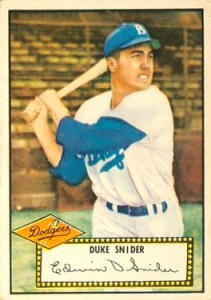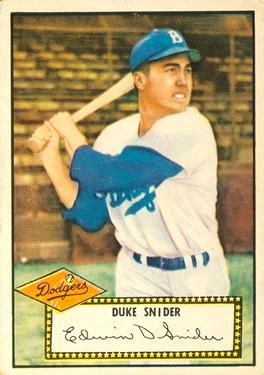October 3, 1953: ‘Let’s Be Unmerciful!’ Dodgers top Yankees in Game 4
 There were other events, including the meanderings of a runaway horse named Red, worthy of ink on the front page of the Brooklyn Eagle on Sunday, October 4, 1953, but after the Dodgers had evened up the World Series the day before, the banner headline, “Let’s Be Unmerciful!” expressed the sentiment of the Brooklyn faithful.1 The Dodgers had stroked 12 hits, including six doubles and a homer, to out-bomb the Bombers of the Bronx, 7-3.
There were other events, including the meanderings of a runaway horse named Red, worthy of ink on the front page of the Brooklyn Eagle on Sunday, October 4, 1953, but after the Dodgers had evened up the World Series the day before, the banner headline, “Let’s Be Unmerciful!” expressed the sentiment of the Brooklyn faithful.1 The Dodgers had stroked 12 hits, including six doubles and a homer, to out-bomb the Bombers of the Bronx, 7-3.
On Saturday, two pitchers from Astoria, Queens, who first appeared at Ebbets Field as teenagers took to the mound for the fourth game of the 1953 World Series. The New York Yankees, leading the Series two games to one, sent left-hander Whitey Ford, who had won 18 games during the season, to the mound. The Brooklyn Dodgers, hoping to even up the Series, countered with righty Billy Loes.
Mental mistakes and sloppy play by the Yankees allowed the Dodgers to take an early lead and withstand a late rally as they evened up the Series, winning 7-3.
With a sense of history, the Dodgers brought back Tommy Leach, who had played for Pittsburgh in the very first World Series, in 1903, to throw out the first pitch.
The Dodgers’ predominantly right-handed-hitting lineup figured out Ford early, scoring three runs in the first inning, bringing cheers from most of the record Ebbets Field World Series crowd of 36,775.
“I overran it. There was some wind, but that’s no excuse. I don’t even think it swerved when it came down. I just overran it.” — Hank Bauer2
Junior Gilliam, a switch-hitter batting leadoff for Brooklyn, lifted an opposite-field fly ball toward the right-field corner that appeared playable. However, Hank Bauer overran the ball, and he was standing in foul territory when the ball landed a foot fair and took a sideways bounce into the seats for a ground-rule double. Pee Wee Reese’s grounder to first baseman Joe Collins advanced Gilliam to third. Jackie Robinson drove in Gilliam with a single to center field, then was forced at second by Gil Hodges. Roy Campanella was up next for Brooklyn and when Ford’s 2-and-0 offering went wild, Hodges advanced to second base. Campanella was walked intentionally. Duke Snider, on a 1-and-0 pitch, drove the ball off the bunting adorning the right-field screen, and his double scored Hodges and Campanella. There was no further scoring as Carl Furillo flied out to Bauer in right, but Brooklyn had an early 3-0 lead, scoring in the first inning for the first time in the 1953 World Series.
Tom Gorman replaced Ford on the mound for the Yankees in the second inning and kept the Dodgers from scoring in the second and third. The only hit in those innings was Gilliam’s second double of the game, a pop fly to short left field that eluded shortstop Phil Rizzuto and left fielder Gene Woodling.
Gorman yielded a run in the fourth inning. With one out, Furillo singled to center field and moved to third on a single by Loes. Gilliam with his third double of the game drove in Furillo with the Dodgers’ fourth run. With Gilliam at second, Billy Martin took the throw from the outfield and attempted the hidden-ball trick. Dodgers manager Chuck Dressen saw Martin wedge the ball in his glove, called for time, and told Gilliam to stay on the bag. Umpire Bill Stewart asked Martin for the ball, and Billy’s attempt at deception was foiled. But Gilliam was stranded as Reese popped up to Martin to end the inning.
Loes was in command on the mound and didn’t allow a hit until Yogi Berra singled in the fourth inning. The Yankees halved the Dodgers’ margin in the fifth inning when Martin tripled, lunching a curveball to right-center field between Snider and Furillo, and Gil McDougald homered. Not an out had been registered at this point, but Loes was able to retire Rizzuto, pinch-hitter Don Bollweg, and Mickey Mantle. Mantle looked at strike three.
“I’ve hit ‘em harder, but I hit that one good enough.” — Duke Snider3
The Dodgers reestablished their four-run lead off Johnny Sain, who entered the game in the sixth inning. Snider homered on Sain’s first pitch. Billy Cox doubled and advanced to third on Loes’ second single of the game. He scored on a fly ball by Gilliam, just beating Bauer’s throw home. Snider’s homer was his fifth in World Series competition – most ever by a National League player. He had previously been in a tie, at four, with Mel Ott of the Giants.
Art Schallock, who had originally signed with the Dodgers in 1946, came on to pitch for the Yankees in the seventh inning. With two out, he walked Campanella. Roy scored from first on Snider’s double to the left-field corner. The Yankees outfield had been playing the lefty slugger to pull and Campanella had ample time to score. The RBI gave Snider four for the game.
“There is always that feeling of sitting on a powder keg when Loes is pitching.” — Tommy Holmes of the Brooklyn Eagle4
The Dodgers took a 7-2 lead into the ninth inning. Loes was unable to survive the inning. Singles by Woodling and Martin and a walk to McDougald loaded the bases with none out. Manager Dressen then called on his bullpen ace, Clem Labine, to wrap things up. After Rizzuto struck out, manager Casey Stengel of the Yankees sent up Johnny Mize as a pinch-hitter. Mize flied to Snider in short center field and the Yankees were down to their last out.
“I sent him in. I thought he’d make it easy. That throw from the outfield was unbelievable.” — Yankees third-base coach Frank Crosetti5
Mantle, batting leadoff for the Yankees, came up for the fifth time having gone hitless, striking out twice. When he struck out in the first inning, he set a record with five consecutive strikeouts in World Series competition. Batting left-handed, he singled off the end of his bat, lining the ball over the outstretched glove of Reese into left field, scoring Woodling. Don Thompson, who had replaced Robinson in left field for defensive purposes, gunned down Martin who, given the green light by third-base coach Frank Crosetti, tried to score from second on Mantle’s hit.
“I tried to lunge in and knock it loose from [Campanella’s] hand but couldn’t.” — Billy Martin6
Thompson’s perfect throw reached Campanella on one hop, and the game was over when Campanella slapped the tag on Martin’s shoulder as he came in standing up, trying to bowl over Campanella.
The Series was even up through four games.
After the game, Stengel said he pulled Ford after one inning to have him ready for Game Seven. The matter proved moot. The Yankees went on win the next two games, needing only six games to take their fifth World Series championship in a row.
Snider would build on his home-run record in World Series competition. He played in three more Series with the Dodgers and his total of 11 is still the standard for a National League player.
Martin, despite being thrown out on the final play of Game Four, had his best World Series, going 12-for-24 with eight RBIs. His 12th hit, a single in the ninth inning of Game Six, clinched the game and the Series for the Yankees. It was the second straight year that Martin’s last-inning heroics had factored in a Series win. In 1952 he dashed in from second base to grab a popup by Robinson with the bases loaded to save the game and Series for New York.
Loes, after his senior year at Bryant High School, started in a Long Island vs. Brooklyn all-star game at Ebbets Field on July 7, 1948. He pitched the first two innings for the Long Island (Queens, Nassau, and Suffolk Counties) team and struck out five batters. He allowed a couple of doubles in the second inning that resulted in Brooklyn’s first run of the game. Off this performance, Loes was selected to represent the Brooklyn Eagle in “Brooklyn Against the World” later that summer. He signed with the Dodgers after the Eagle team concluded its travels to Washington, D.C., three Canadian provinces, and Providence, Rhode Island.
Ford first appeared at Ebbets Field in Brooklyn Against the World in 1946, playing in right field and going 0-for-4 in the second game of a series between the Brooklyn Eagle team and a World team comprising 20 players from cities across the United States, Canada, and Hawaii. He was scheduled to pitch the middle three innings of the game on August 9, 1946, but Dressen, who was managing the Brooklyn kids, did not put Ford in the game. When Whitey took the mound at Ebbets Field for the first time, on October 3, 1953, Dressen was looking on from the opposition dugout.
SOURCES
In addition to the sources cited in the Notes, the author consulted Baseball-Reference.com, Retrosheet.org, and the following:
Broeg, Bob. “Dodgers Win, 7-3, Square Series at 2 Each; Snider Bats in Four Runs with Homer, 2 Doubles,” St. Louis Post-Dispatch, October 4, 1953: Part 5, 1.
Holmes, Tommy. “Dodgers’ 7-3 Win Ties Series,” Brooklyn Eagle, October 4, 1953: 1, 22, 32.
Kahn, Roger. “Martin’s Mad Dash for Home in 9th Humors Dodger Clubhouse,” New York Herald Tribune, October 4, 1953: B2.
Lee, Bill. “With Malice Towards None,” Hartford Courant, October 4, 1953: Section 4,1.
Rennie, Rud. “Snider Bats in 4; Loes, Labine Halt Champions,” New York Herald Tribune, October 4, 1953: B1.
Smith, Red. “Views of Sport,” New York Herald Tribune, October 4, 1953: B1.
Stockton, J. Roy. “Extra Innings: Dodgers Brush Off Early Defeats,” St. Louis Post-Dispatch, October 4, 1953: Part 5, 1.
Young, Dick. “Dodgers Tie it Up! Blast Yanks, 7-3,” New York Sunday News, October 4, 1953: 96.
NOTES
1 Brooklyn Eagle, October 4, 1953: 1.
2 Joe Trimble, “Crow Sits on His ‘Rock’; Chuck’s Mum on Pitcher,” New York Sunday News, October 4, 1953: 98.
3 John Drebinger, “Dodgers Down Yankees, 7-3, for 2-2 World Series Tie,” New York Times, October 4, 1953: Section 5, 2.
4 Tommy Holmes, “Dodgers Win 7-3 to Even Series,” Brooklyn Eagle, October 4, 1953: 32.
5 Ted Smits (Associated Press), “Don Thompson Made Perfect Peg to Plate,” Lancaster (Pennsylvania) Sunday News, October 4, 1953: 32.
6 Trimble, “Crow Sits on His ‘Rock.’”
Additional Stats
Brooklyn Dodgers 7
New York Yankees 3
Game 4, WS
Ebbets Field
Brooklyn, NY
Box Score + PBP:
Corrections? Additions?
If you can help us improve this game story, contact us.


